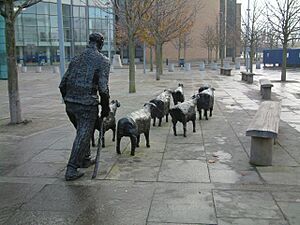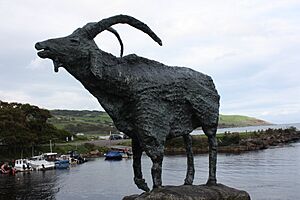Deborah Brown facts for kids
Quick facts for kids
Deborah Brown
HRUA
|
|
|---|---|
| Born | 27 September 1927 Belfast, Northern Ireland
|
| Died | 8 April 2023 (aged 95) Donegal, Ireland
|
| Education | Belfast School of Art |
| Alma mater | National College of Art & Design, Dublin, Ireland |
| Known for | Sculpture & painting |
Deborah Brown (born September 27, 1927 – died April 8, 2023) was a famous sculptor from Northern Ireland. She was well known for being one of the first artists in Ireland to use a material called fibre-glass in her sculptures during the 1960s. Her amazing work made her one of the top sculptors in the country, and she became famous all over the world.
Early Life and Inspiration
Deborah Brown was born in Belfast, Northern Ireland, on September 27, 1927. She was an only child and loved nature. She spent her childhood in Cushendun in the beautiful Glens of Antrim. Her grandmother was a big help, encouraging her art and giving her paints and materials when she was very young.
In 1934, her family moved to Cushendun. Their house was designed by Tom Henry, who was the brother of the famous painter Paul Henry. Deborah said her mother taught her to love animals. Growing up in the countryside, helping with farm work like picking potatoes and cutting hay, really influenced her art.
Learning to Be an Artist
Deborah had her first art lessons from James Humbert Craig, who lived nearby. She went to Belfast Royal Academy and later Richmond Lodge School. She also took private art lessons in Belfast. To get ready for art college, she learned about art history from James McCord.
In 1946, Deborah studied landscape painting at Belfast College of Art. Then, in 1947, she went to the National College of Art and Design in Dublin for three years. There, she studied painting and sculpture. She also learned art history at the National University. Deborah was also a talented musician, playing the bass viol after learning piano and cello when she was young.
After Dublin, she continued her studies in Paris for three months. In Paris, she became very interested in the bright, simple colors used in European Modernism. She visited famous museums like the Jeu de Paume and the Louvre. She saw the works of famous artists like Picasso, Giacometti, Matisse, and de Staël.
As a student, she often visited art galleries in Ireland. Her abstract paintings were greatly inspired by artists like Mark Rothko, Jackson Pollock, and William Scott.
Her Artistic Journey and Famous Sculptures
When Deborah returned to Belfast in 1951, she was 24 years old. She got ready for her first solo art show at the CEMA Gallery. The poet John Hewitt even wrote the introduction for her show's catalog. Her exhibition featured 35 oil paintings, mostly showing landscapes, woods, and rivers.
That same year, Deborah became friends with Alice Berger Hammerschlag. After Alice passed away, Deborah was asked to help set up a special art fund in her memory. This fund helped many young artists travel and buy art supplies.
In 1955, a Scottish artist named John D Fergusson saw Deborah's work. He invited her to show her art in Glasgow, Scotland. The next year, she had another solo show in Belfast with 36 paintings. These paintings used strong, bold colors and a free, expressive style.
From Painting to Sculpture
In 1956, Mary O'Malley saw Deborah's abstract paintings. She asked Deborah to paint some stage sets for the Lyric Theatre in Belfast. Deborah's work on stage designs and props made her interested in creating sculptures.
In the 1960s, Deborah traveled around northern Italy. She visited cities like Rome and Florence. There, she studied the works of famous sculptors and painters like Botticelli, Donatello, and Michelangelo.
Deborah joined several art groups in the early 1960s. She also worked in her father's office to earn money. She even took exams to learn about the history of furniture, silver, and painting. Later, she became a partner in the family business. In 1965, she received a big order to create eight large panels for the Ferranti Building in Manchester. These were her last purely abstract works.
From the mid-1960s, Deborah's art changed. She moved from making flat papier-mâché art to creating more three-dimensional pieces. A friend suggested she try working with fibre-glass, and she loved it! In 1966, she had a solo exhibition at the Hendricks Gallery. In 1969, she had another show at the Arts Council of Northern Ireland gallery. She even donated a painting to help raise money for people affected by civil unrest in Belfast.
In 1970, Deborah won the "Carroll Open Prize" for painting at the Irish Exhibition of Living Art. She won for a red and black fibre-glass sculpture on canvas. Throughout the 1970s, she was the chairperson of the Visual Arts Committee of the Arts Council. In 1973, she represented Ireland at an international art festival in France.
In 1982, the Arts Council held a big show of her work at the Ulster Museum and the Hugh Lane Municipal Gallery. Two years later, she was invited to show her art with seven other Irish artists in New York. Around this time, Deborah retired from her father's business. She moved back to Cushendun and turned two old buildings into her art studio.
The Story of Johann the Goat
Back in Cushendun, Deborah mostly worked on animal sculptures using wire and papier-mâché. Her agent, Sheelagh Flanagan, helped her cast her first sheep in bronze. She also cast a life-size papier-mâché goat in bronze for Lord Belmore. This goat, named Johann, belonged to the local vet in Cushendun. Sadly, Johann had to be put down during the Foot and Mouth crisis in 2001.
Today, the bronze sculpture of Johann sits in the same spot where the real goat used to be. It has become a popular landmark in the area. Deborah's animal sculptures were shown at Flanagan's Shambles Gallery in 1989.
In 1987, a self-portrait by Deborah was added to the National Self Portrait Collection of Ireland. In 2016, she won the "Mullan Gallery Prize" for the best sculpture at the Royal Ulster Academy exhibition for her work called The Visitor.
Her Final Years
Deborah Brown passed away on April 8, 2023, in Donegal. She was 95 years old and had spent many of her later years in the town of Ramelton.
Her Artistic Mark
Deborah Brown's art is part of many important collections in Ireland and other countries. These include the Ulster Museum, Raidió Teilifís Éireann, Bank of Ireland, the Hugh Lane Municipal Gallery, the Irish Museum of Modern Art, the Arts Council of Northern Ireland, and the National Self Portrait Collection of Ireland.
Important Artworks
- Sheep on the Road (1991): This life-size bronze sculpture was first ordered by the Arts Council of Northern Ireland. In 1999, it was bought by the Laganside Corporation and moved to the entrance of the Waterfront Hall in Belfast.



